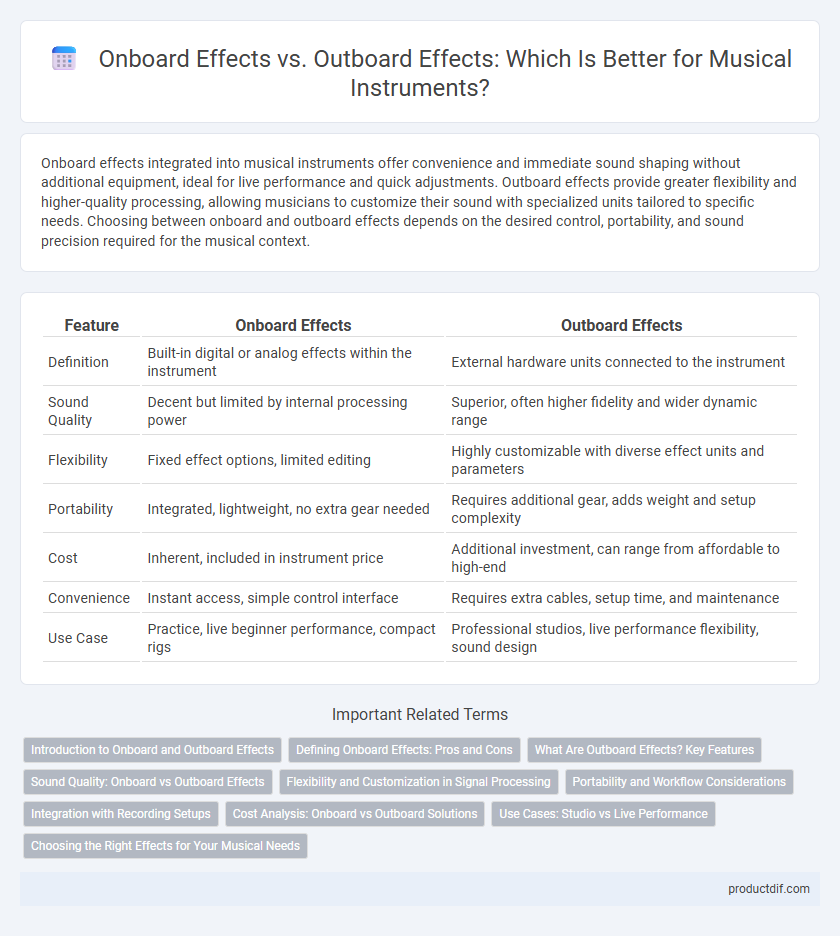Onboard effects integrated into musical instruments offer convenience and immediate sound shaping without additional equipment, ideal for live performance and quick adjustments. Outboard effects provide greater flexibility and higher-quality processing, allowing musicians to customize their sound with specialized units tailored to specific needs. Choosing between onboard and outboard effects depends on the desired control, portability, and sound precision required for the musical context.
Table of Comparison
| Feature | Onboard Effects | Outboard Effects |
|---|---|---|
| Definition | Built-in digital or analog effects within the instrument | External hardware units connected to the instrument |
| Sound Quality | Decent but limited by internal processing power | Superior, often higher fidelity and wider dynamic range |
| Flexibility | Fixed effect options, limited editing | Highly customizable with diverse effect units and parameters |
| Portability | Integrated, lightweight, no extra gear needed | Requires additional gear, adds weight and setup complexity |
| Cost | Inherent, included in instrument price | Additional investment, can range from affordable to high-end |
| Convenience | Instant access, simple control interface | Requires extra cables, setup time, and maintenance |
| Use Case | Practice, live beginner performance, compact rigs | Professional studios, live performance flexibility, sound design |
Introduction to Onboard and Outboard Effects
Onboard effects are built directly into musical instruments or amplifiers, providing immediate access to sound modification features such as reverb, delay, and distortion without additional equipment. Outboard effects are external devices connected to instruments or mixing consoles, offering more extensive control and higher-quality processing through dedicated hardware units like pedals, rack-mounted processors, or multi-effects units. Musicians often choose onboard effects for convenience and portability, while outboard effects are preferred for enhanced sound customization and professional studio applications.
Defining Onboard Effects: Pros and Cons
Onboard effects are integrated digital or analog processors built directly into musical instruments, offering convenience and portability by eliminating the need for external gear. Their pros include instant accessibility and streamlined setups, while cons involve limited effect variety and potential compromises in sound quality compared to specialized outboard units. Musicians often weigh the trade-off between ease of use and sonic flexibility when choosing onboard effects for their performances or recordings.
What Are Outboard Effects? Key Features
Outboard effects are external audio processors used to enhance a musical instrument's sound by applying effects such as reverb, delay, chorus, or distortion outside the instrument or digital audio workstation. Key features include hardware units with dedicated controls for precise parameter adjustments, superior sound quality often attributed to analog circuitry, and flexibility to be integrated into various signal chains or studio setups. These units offer musicians hands-on manipulation and distinctive tonal characteristics that differ from onboard effects, providing greater creative possibilities.
Sound Quality: Onboard vs Outboard Effects
Onboard effects often provide convenience and integration with musical instruments but may compromise sound quality due to limited processing power and lower-quality components. Outboard effects units deliver superior audio fidelity, offering more precise and dynamic sound manipulation with dedicated hardware designed specifically for signal processing. Musicians prioritize outboard effects when achieving professional-grade tone and nuanced sound textures is critical.
Flexibility and Customization in Signal Processing
Onboard effects provide seamless integration with musical instruments, allowing musicians to quickly access a variety of signal processing options without additional gear, ideal for live flexibility. Outboard effects offer greater customization through dedicated hardware units, enabling precise control over parameters and the use of specialized processors like analog compressors, reverb units, or multi-effects racks. Combining onboard and outboard effects expands sonic possibilities, blending convenience with tailored sound shaping for professional audio production.
Portability and Workflow Considerations
Onboard effects are integrated directly into musical instruments, offering superior portability by eliminating the need for extra gear, which is ideal for mobile musicians and live performers. Outboard effects, while less portable due to additional hardware requirements, provide enhanced flexibility and typically higher audio quality, benefiting studio workflows and detailed sound design. Choosing between onboard and outboard effects depends on balancing the need for compact setup and ease of transport against the desire for expansive control and superior processing capabilities.
Integration with Recording Setups
Onboard effects provide seamless integration within digital audio workstations, reducing latency and simplifying signal routing by embedding processing directly into the instrument or interface. Outboard effects offer greater sonic flexibility and unique tonal characteristics but require additional hardware connections and careful gain staging to maintain audio fidelity. Choosing between onboard and outboard effects depends on workflow preferences and the desired balance between convenience and sonic customization in professional recording environments.
Cost Analysis: Onboard vs Outboard Solutions
Onboard effects offer a cost-effective solution by integrating multiple processing tools directly within a musical instrument, reducing the need for additional gear purchases and minimizing setup expenses. Outboard effects units, while often providing superior audio quality and specialized capabilities, entail higher costs due to separate hardware acquisition, maintenance, and potential connectivity requirements. Musicians must weigh the initial investment and long-term flexibility of onboard processing against the premium quality and expandability of outboard effects when planning their budget.
Use Cases: Studio vs Live Performance
Onboard effects are integrated into musical instruments or amplifiers, offering convenience and quick adjustments ideal for live performance where portability and immediacy matter. Outboard effects units provide superior sound quality and greater versatility, favored in studio settings for detailed sound shaping and multi-effect chaining. Musicians often rely on onboard effects for spontaneous stage setups, while studios utilize outboard gear to achieve professional-grade audio production.
Choosing the Right Effects for Your Musical Needs
Onboard effects offer convenience and seamless integration with your instrument, ideal for live performances requiring quick adjustments and minimal setup. Outboard effects provide superior audio quality and versatile sound shaping options, preferred in studio environments where precision and customization are crucial. Selecting the right effects depends on whether portability and ease-of-use or advanced processing capabilities better suit your musical style and production demands.
Onboard effects vs Outboard effects Infographic

 productdif.com
productdif.com